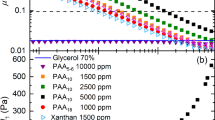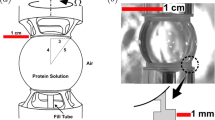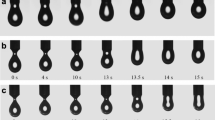Abstract
THE purpose of this communication is to present some experimental results obtained during a laboratory investigation of the mechanism of the breakup of drops. Results of previous workers indicate that drop deformation and turbulent air flow are major factors in the break-up of drops suspended in the air stream of vertical wind tunnels. Shattering break-ups have been observed for drops 5–9 mm. in diameter as a result of sudden changes in the velocity of the wind stream, or as a result of collisions between drops1. The fragments from the disintegrations of one hundred parent drops between 9 and 12 mm. in diameter have been collected and a size distribution determined2. No account of the actual mechanism of break has come to our notice, although factors responsible for the deformation of drops between 5 and 7 mm. in diameter have been evaluated3.
This is a preview of subscription content, access via your institution
Access options
Subscribe to this journal
Receive 51 print issues and online access
$199.00 per year
only $3.90 per issue
Buy this article
- Purchase on Springer Link
- Instant access to full article PDF
Prices may be subject to local taxes which are calculated during checkout
Similar content being viewed by others
References
Blanchard, D. C., Occasional Report No. 17, Project Cirrus.
D'Albe, and Hidayetulla, Quart. J. Roy. Met. Soc., 81, 610 (1955).
McDonald, J. Meteor., 11, 478 (1954).
Author information
Authors and Affiliations
Rights and permissions
About this article
Cite this article
MAGARVEY, R., TAYLOR, B. Shattering of Large Drops. Nature 177, 745–746 (1956). https://doi.org/10.1038/177745b0
Issue Date:
DOI: https://doi.org/10.1038/177745b0
This article is cited by
-
Single-drop fragmentation determines size distribution of raindrops
Nature Physics (2009)
Comments
By submitting a comment you agree to abide by our Terms and Community Guidelines. If you find something abusive or that does not comply with our terms or guidelines please flag it as inappropriate.



